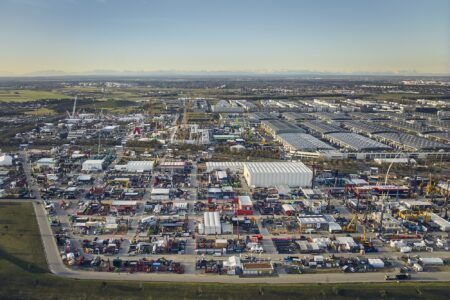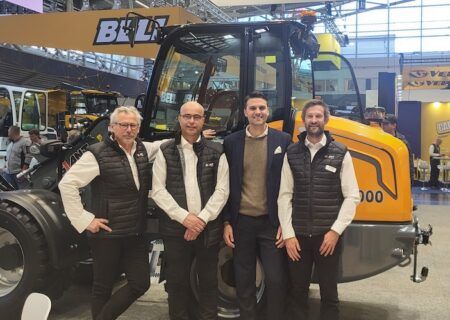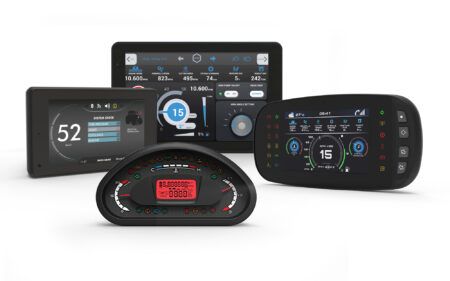Agritechnica, which is scheduled to take place from 27 February to 5 March 2022 in Hanover, Germany will be offering a showcase of technologies for the enablement of autonomous mobility within its concurrent Systems & Components event.
The requirements being made on the productivity, comfort and safety of mobile machines in the off-highway sector are constantly increasing. Assistance systems and partially automated solutions are making it easier for the driver in the cab for work carried out on either the field or on a construction site.
Steep gradients, sharp drops, tight bends and spaces that are difficult to manoeuvre require not only maximum concentration but also complete control in the cockpit of mobile working machines. In this context, advanced assistance systems have the task of supporting the driver in the cab. Increasing automation of such systems will reduce the workload on the machine operator, thus enabling him to concentrate on the task at hand, e.g. monitoring and optimising the work process.
At the same time, the assistance systems are poised to intervene in the event of hazardous situations, for example through the avoidance of collisions when reversing on a construction site or other situations in which visibility is reduced.
On the road to market-ready solutions
High performance assistance systems not only ensure increased safety and improved efficiency on fields or construction sites, they are also aimed at paving the way to autonomous solutions. When this objective is transferred to the system architecture of tractors, harvesting machines or excavators, it means that an increasing volume of data originating from a growing number of sensors is being processed.
Ultimately, this information has to be presented intuitively to the operator on the display in the cockpit. Systems & Components will be providing a look ahead to what can be expected over the next few years in the off-highway sector – as the next generation of self-propelled vehicles will be able to move and operate autonomously.
Many technology providers exhibiting in Hanover have already presented solutions that will be important building blocks of autonomous functions such as electrohydraulic steering in off-highway vehicles. Speed, steering and vehicle control functions keep the machines on track and can automatically position combine harvesters at the cut-edge of the field.
One of the central themes at Systems & Components will be how to achieve the next level of autonomy. The starting point for this is marked by the latest generation of steer-by-wire, drive-by-wire and brake-by-wire functions. By enabling the elimination of the steering column, for instance, such systems offer increased flexibility in machine and cab designs.
Increased freedom and comfort in steering
Discussion and interest in digital steering, driving and brake systems is likely to pick up pace at the trade fair grounds in Hanover, as the suppliers of these technologies have their sights set firmly on market-ready solutions for volume production for the off-highway markets. Unlike in the automotive sector, retrofit solutions are often in demand in the agriculture and off-highway sector, as for companies it is often not viable to replace the entire vehicle fleet in order to obtain autonomous functionalities.
The systems on display in Hanover will demonstrate the integration of the entire process from the steering wheel and the brake pedal to the axle and will enable intuitive tactile feedback directly to the vehicle operator. Implementation is carried out in the form of mechatronic, hydraulic or hybrid solutions that initiate braking or turning maneuvers in fractions of a second. It is claimed that they are at least as safe as conventional systems using mechanical transmission paths. A safety system with multiple redundancy ensures that correct sensor values are always transferred and processed.
Electric steering not only promises increased driving comfort and precision for tractors and self-propelled harvesting machines, but also enables vehicle operation in critical situations without the need for an operator in the cockpit. The driver exits the vehicle, activates the radio remote control and controls the vehicle from the exterior. This example shows that the farmer and tractor will remain a team, although machines will operate autonomously on the fields in the future.
These technical capabilities have also arrived in other off-highway sectors. While many agricultural machinery manufacturers are still in the project or pilot phase, particularly due to the lack of a legal framework surrounding autonomous driving in the public areas, autonomous driving is already part of daily life in open-cast mining. In the massive raw material mines operated by Australian mining company Rio Tinto in Australia, for example, autonomous Komatsu dumper trucks fitted with the Autonomous Haulage System (AHS) transport iron ore without a driver at the wheel are now in use. They navigate with the aid of high-precision GPS, while radar and laser sensors enable them to detect obstacles.
Sensor fusion for increased reliability
Sensor systems are the sensory organs of mobile machines and are therefore also very high up on the technology providers’ road map. The objective is maximum precision for the identification of not only inanimate objects, but also people and animals. The prerequisite for this is reliable 360-degree detection of the surrounding environment, often unstructured terrain.
The current sensor and camera technologies and the matching image processing algorithms now enable assistance systems that are adapted to customers’ respective requirements and the type of mobile working machine. In implementing this, the developers are not simply relying on one single sensor type: a complete model of the environment is only achieved by combining the information from various sensors, known as sensor fusion – a fundamental prerequisite for the reliability and safety of driver assistance systems and autonomous driving.
The use of LiDAR sensors is increasingly complementing camera, radar and ultrasound technologies. These sensors are aimed at helping autonomously operating working machines to achieve a breakthrough in the off-highway sector, and are considered by experts such as Aine Denari of ZF’s Electronics and Advanced Driver Assist Systems division, to be one of the key technologies. The LiDAR systems register the surroundings on the basis of visible, ultraviolet or infrared light and generate a seamless 3D point cloud, even in rain, fog, dust or darkness.





